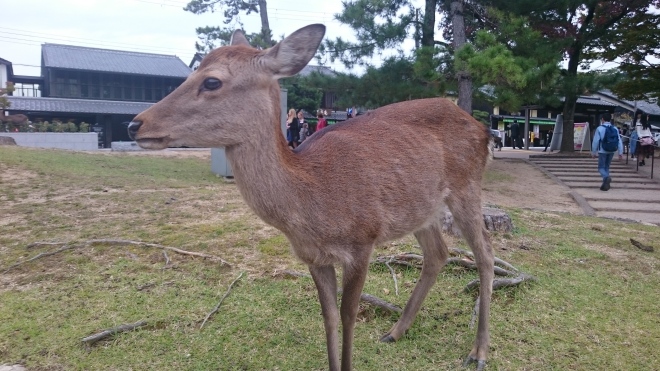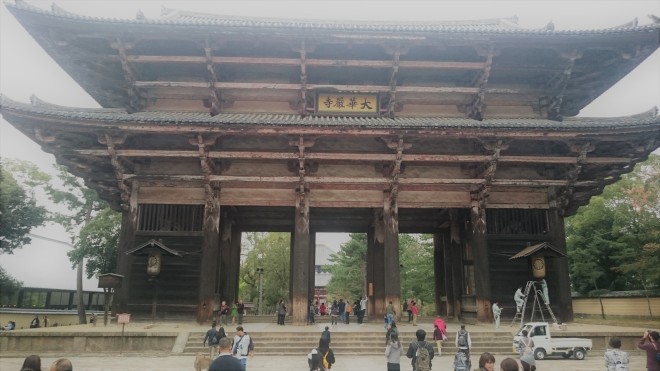The ancient city of Nara, an experiment in technological and spiritual innovation. The watermark of a nation in bloom, and a defining point in the portrait of a culture.
I had developed an interest in Nara soon after arriving in Japan, following an encounter with an old friend. We were having lunch, discussing the trials and tribulations of rural Japan, when the subject came up—she had just returned from there on business, and said it had been an altogether pleasant trip. Though I had some knowledge of the city and prefecture beforehand, I had never been, nor had I made any plans to do so; however, after our conversation I became increasingly taken by the idea of visiting. I am fortunate to be spending a few days in Nabari, in neighbouring Mie prefecture (some 65km from Nara City) making the journey convenient if nothing else.
The City of Nara lies in the mountainous Yamato Basin, close to the Kyoto border, where she has done for some 1300 years. Built in the 8th century, the city was modelled on the ancient city of Ch’ang in the hope that it might emulate the splendour of the Tang Dynasty. It became the home of the Imperial Court and capital of Japan, and lends its name to the subsequent period (Nara-jidai) from 710 – 794. These days however Nara makes do with the title of prefectural capital, and is home to some 350,000 people, who live and work throughout the city and its suburbs. Though modestly sized (at least by Japanese standards) the city retains a historical and cultural significance that rivals even the largest of its contemporaries—the prefecture hosts more UNESCO heritage sites than any other.
The drive from Mie to Nara is in itself an experience worth writing about: up through the forests and winding roads, into the mountains; and then down, into the basin itself, where you are met by a panoramic view of the sprawling suburbs, the lights of commerce sparkling throughout. A sight for sore eyes. When travelling through the Japanese countryside, I am often astonished by the volume of undisturbed woodland. In fact some 67% of Japans land mass is accounted for by trees—to put that in context the UN average is 29%, with England retaining around 10%—making it one of the most densely forested countries in the world. Nara is no exception, its sloping, wooded hills giving shelter to one of the city’s most prized treasures: the Sika.
Just as one cannot mention Venice without gondolas, nor Prague without Kafka, a discussion on Nara seems incomplete without some reference to deer. The Sika, or Japanese Spotted Deer, are ubiquitous throughout the prefecture, though most notably in the city itself, where approximately 1200 Sika (as of 2015) coexist alongside their two-legged counterparts. A particularly interesting phenomenon, given that deer are so renowned for the shyness, and I’m sure one could spend a whole day studying their interactions with the environment and never tire of it—this can make for many a fascinating, and often amusing spectacle. For example, the deer have adopted certain idiosyncrasies specific to the urban setting, such as bowing to receive food, and waiting with pedestrians at traffic lights. The level to which they seem to have integrated into society is also noteworthy. For many Narans the Sika are a central feature of everyday life. I speak to a café owner, who tells me that one particular deer has been coming to her store since a young fawn, and now brings his family to receive scraps.

This arrangement of cohabitation seems, at least at first glance, to be one of mutual benefit. Tourists flock in to see the deer, which has spawned an industry in Shika-senbei (or ‘deer snacks’) that can be purchased and fed to them; the deer have in turn been allowed some degree of autonomy, being left to roam the city and Nara Park—where they are predominantly found. There are however some, perhaps unsurprising, problems that arise from cohabitation. The deer population has been steadily rising over the years, and with incidence of deer attacks on the rise, as well as a general strain on the local environment and infrastructure, it has prompted a question of ‘how many deer are too many’, and what should be done about it? There have been talks of a cull within local government, though this has (at least for the meantime) been shelved in favour of a relocation programme—largely due to public outcry.
This is more than an issue of animal rights, or protecting the tourism economy, however. Equally significant is the importance of the Sika to Nara’s culture and identity on an esoteric level. Legend has it that the Shinto thunder deity takemikazuchi-no-mikoto rode into Nara atop a white deer, where he was summoned to guard the Kasuga Taisha shrine; as such the Sika were for many years considered sacred and protected under pain of death. Whilst the scope of Japanese religious observance may have changed in the years between then and now, deer are still revered throughout the country; which is perhaps a good example of how certain values become entrenched over time, transcending the esoteric into common sense—that is to say, religion influences culture (and vica-versa).
Upon entering the Tōdai-ji, one cannot help but reach for the word ‘magnitude’. The sprawling complex is in itself a tremendous achievement both in size and engineering, though it is perhaps the Daibutsu (or bronze Buddha ornament) that is most exceptional. Standing at nearly 50 feet in height, it is the largest statue of its kind, and is housed in the Daibutsu-den (or Great Buddha Hall) which until the 90s was the largest wooden building in the world. I’m sure you can see where I’m going with this, but suffice to say, when it comes to Buddhism in Nara, size matters; and perhaps that is only right, Nara is after all Japan’s first quintessentially Buddhist city and template for the subsequent Heian Kyo—modern day Kyoto.

Standing in the courtyard, on a gravelled path leading to the Daibutsu-den, it is grey and overcast. Whilst I’m sure a bright, autumnal sky would make for a stunning picture, perhaps the clouds and drizzle lend to the conservative splendour of the place—much as a foggy day in London is almost a prerequisite to experiencing the city. The romantic in me tries to imagine the place as it was 1200 years ago, with the crowds of tourists replaced by monks and worshippers, though I’m not sure how helpful this is as the complex has been renovated numerous times since its inception. Inside the enclosure the Daibutsu cuts an imposing figure, and one can see how such a structure would inspire reverence in the hearts of all who came to supplicate before it. It is said that the amount of bronze used alone nearly bankrupted the nation, and took multiple attempts to cast. Nevertheless, it remains awe inspiring both in size and presence, and one cannot help feeling humbled before it.

Outside it is growing dark, though I decide to take a final stroll through Nara Park before departing. Nara Park is in fact one of the oldest parks in Japan, having been built towards the end of the 19th century during the Meiji restoration; and like so much in Nara, it is also beautiful. The leaves are turning as autumn sets in, in a spectacular canopy of green, orange and brown. Couples walk hand in hand along the pathways and stag joust with one another nearby. I have always felt autumn to be my favourite season, and this is especially true in Japan—something about the oak and maple in particular. The atmosphere there is one that I feel resonates with Nara as a whole: peaceful and understated.
I decide to visit the Kasuga Taisha, a Shinto shrine tucked away in Nara park, before making the journey home. Built in 768 it was dedicated to the illustrious Fujiwara clan, who rose to prominence under the enigmatic Fujiwara Kamitari, and remained the de-facto rulers of Japan throughout much of the Nara and following Heian period. The family name remains a significant one, and the Fujiwara Kamon (depicting a wisteria vine) is not an uncommon sight—especially in Nara and Kyoto, where the clan exercised considerable power. The shrine is noted for its collection of stone lanterns adorning the grounds and those of the park in which it is situated, of which there are some 3000. Each one is said to have been donated by a worshipper, in an act of devotion that seems almost banal by this point in my trip. The shrine also hosts the Kasuga Wakamiya on-Matsuri, a festival and celebration of feudal Japanese culture (particularly the Heian era), though I am visiting at the wrong time of day and year to experience this first hand. Instead I content myself with wandering through the shrine, enjoying its ambience as the light slowly fades.
There is much to be said about Nara, indeed much more than I can articulate in these brief paragraphs. In finality, It is clear that Buddhism (and to some extent Shinto) has played an important part in Nara’s identity and Raison-d’etre; whilst Nara itself has contributed towards shaping the Japanese identity, at least in the historical sense. It is then somewhat like a brush mark, on a historical canvas, giving definition to a national portrait. There are indeed many such brush marks, though it is only by studying these indentations that we can seek to comprehend the broader picture, which is itself an ever growing ‘work in progress’.